Abstract
Foldable furniture is a trend of the modern furniture industry. However, apart from limitations attributed to multifunctionality and space saving characteristics, a complete design process documentation of foldable furniture is uncommon in furniture research. This study aims to develop a space-saving multipurpose table for improved ergonomic performance. Features and functions are extracted from research articles and patents for concept generation. The final concept is modelled using Autodesk Inventor Professional 2019. Mechanical simulations are done to confirm the structural integrity of the invention before prototyping and testing. The tests accounted for usage efficiency, space and usability. Using Minitab 19, the experimental data are analysed with t-tests. The survey data are analysed using Spearman’s correlation test via IBM SPSS Statistics version 21. Participants were able to complete tasks around 1.1–1.5 times faster with the proposed invention than with single-function furniture items. The amount of space occupied with the proposed invention was approximately 25–80% lesser than with the single-function furniture items placed together. The survey analysis demonstrated that there was a strong, positive and significant correlation between space saving effectiveness and ergonomic performance. Further developments to transition this invention to its commercialisation phase should be done to facilitate daily living domestic activities of society at large.
1. Introduction
In spatial design, saving space is important to optimise energy usage, thermal comfort and visual comfort [1,2], especially for tiny homes which emphasise smaller spaces for more sustainable lifestyles [3,4]. The impact of tiny homes on the environment can be considerably reduced with the use of flexible and efficient equipment or furniture that are foldable, modular, space-saving and/or multifunctional [5,6,7,8].
Foldable furniture items are among the trends of modern-day furniture design [9]. The vast majority of people in some of the most highly populated cities live in small buildings or flats mostly due to lack of space [10]. By considering foldability in the design, a furniture item would not only become more portable but also more convenient to use, especially in limited spaces. The improvement of modularity and multifunctionality in design addresses the problem of limited spaces [11].
The furniture industry uses wood as its primary raw material and largely consumes natural resources from forests, generating tonnes of waste [12]. In the urban and domestic context, approximately nine million tonnes of furniture are discarded into landfills each year [13]. While a regular single-function device (like many furniture items) is discarded, as time goes by, a multifunctional device sustains its use for a longer time due to the additional functions it possesses, catering to a broader scope of needs [14].
1.1. The Table
The table is a furniture item with legs and a levelled top usually utilised as a surface for office work, utility work, serving and consuming meals and for placing items on. In the past, tables were made out of stone. As time went on, wood was often used, as it improved the table’s manufacturability. After the first industrial revolution, table production and availability increased significantly as the production evolved from craft to mass production, which relied on machines, electricity and assembly lines [15].
Tables have been designed to accommodate multiple functions such as the functions of a chair, coat rack or cupboard [16]. While the table has become more portable, foldable, modular and multifunctional over the years [10], there are still some limitations in these improvements which allude to the problem statement of this study.
1.2. Problem Statement
With the outbreak of the COVID-19 pandemic, confinement has been used as a global public health precaution for prevention, and this has resulted in new “normals”, such as remote working, telework and working from home (WFH) [17]. The pandemic has revealed the critical importance of having a practical home capable of accommodating any unanticipated change or problem, especially given the severity of the viral mutations involved. There has never been a greater demand for innovations in small space living than there is now, particularly in metropolitan cities [18].
On the other hand, the social structures of the twenty-first century are undergoing a metamorphosis under the auspices of a paradigm that values creativity, functionality, and efficiency. As a result, newly developing lifestyles in the wake of the pandemic’s transformation of societal structures are more relevant than ever, with people juggling jobs and family management, as well as responding to lifestyle demands [19]. In densely crowded cities, the fundamental challenge of sustainable housing and outfitting in meeting everyday demands remains significant [18,19]. Even consumer purchasing behaviours and expectations are continually being altered in response to the pandemic [20].
The important aspects deemed necessary for people in their remote spaces include daylighting, room size, room temperature, furniture, surface finishes and external views [17]. However, there is a misconception in people’s views on the suitability of furniture, as evidenced by the excessive usage of dining room furniture for telework or, more broadly, the use of non-specialised house furniture in a constrained space [17]. Alternatively, monitoring consumer purchasing behaviours in terms of preferences and attitudes has been identified as a critical factor in the success and development of a variety of businesses, including wood furniture production [20].
Consumer behaviour is seen as critical for effective marketing, trustworthy production management, and the success of research and development efforts [21]. It is about comprehending how individuals, communities and organisations select, acquire, utilise and discard items, services, ideas and experiences to fulfil their desires and needs. The primary objective of marketing is to fulfil the desires and needs of the consumer target group [22]. On the other hand, some users do have their own preferences in terms of furniture materials, and furniture made of wood might be less preferred when their country of origin does not produce wood extensively [23]. Additionally, even if a furniture item is not completely functional, it can be a status symbol and regarded as a long-term investment to many [20].
Preferences are common in the consumer market, and consumers are frequently forced to select between multiple choices [24]. Consumers analyse and evaluate the product’s functional benefits during this phase, weighing alternatives against a variety of criteria and frequently deliberating for an extended period before making a final decision. This decision-making process is especially true for higher-priced products such as furniture, where purchasers weigh their options carefully [25]. As a result, customers place a higher premium on their money, the things they purchase and the risks associated with product selection [21]. Functionality is the most important factor in the buying decision process, surpassing both quality and design [20]. Additionally, design considerations will play a greater part in green supply chains in the future, as eco-labelling allows consumers to make sustainable purchasing choices [26].
Space-saving furniture is the way forward in addressing these issues by combining the importance of ergonomics with the anthropometric principles of multipurpose space-saving furniture configurations in various locations [18]. Space-saving furniture design is prevalent in our daily lives and businesses, taking into consideration that the average living space of people in the world’s major cities is shrinking. Effective space-saving does not require downsizing, but rather ingenious methods of collapsing or making a foldable piece of furniture. Foldable furniture can serve a variety of purposes. Amidst the rising cost of living, the increase in demands for economical and transformable space-saving furniture is not surprising [18].
There are indeed existing designs of foldable, modular and multifunctional tables in the market. Each design possesses a few key functions which are unique and distinguishable. As the usage of such tables becomes increasingly common, problems concerning the design begin to surface. The general characteristics of these problems are related to the tables’ flexibility, portability, occupied space and multifunctionality.
Most of the existing designs share the same features such as foldable legs, collapsible table surface and adjustable table height. These features are considered in modern table designs to accommodate the issue of insufficient space in small homes [10]. However, limitations such as the complexity of the design create difficulties for users, especially in assembly, ease of use, and transformation to other functions.
Another limitation includes the lack of multifunctionality. While there have been multifunctional table designs, the common multifunctional aspects often include the table being folded into a chair or simply being attached with a chair. Although such tables have been made to have more than one function, the designs can hardly be considered multifunctional, much less inventive. Moreover, the complete design process of multifunctional furniture that entails conceptualisation, mechanical design and proof of concept is often less commonly documented compared to other furniture design studies.
The above-stated limitations point out that there has yet to be a study that emphasises the conceptual synthesis and development of a multipurpose table capable of optimising usage space with less complex design features and more functions than existing designs. Therefore, the following research questions can be proposed.
- RQ1: How can a table be conceptualised and developed mechanically for improved multifunctionality and space-saving characteristics?
- RQ2: How can the proof of concept and ergonomic performance of the proposed invention be demonstrated?
With reference to the research questions, this study aims to conceptualise and develop a space-saving multipurpose table for improved ergonomic performance.
2. Literature Review
2.1. Scholarly Research on Furniture Designs
Considering the significance of space-saving attributes in modern day furniture, researchers have introduced a concept known as foldabilising furniture designs [27]. In their study, researchers emphasised one instance of the problem, where folding is with respect to a prescribed folding direction and allows for space-saving aspects in the design through hinge insertion and part shrinking.
The types of space-saving mechanisms include stacking, bundling, implosion and folding [28]. Among these mechanisms, folding is recognised as the most frequently-used feature in modern furniture designs.
A study was conducted in 2016 that focussed on the incorporation of a pneumatic adjustable system into a table for height adjustment and tilting of the table top. This table is integrated with a drawer as an additional function. The pneumatic cylinder is attached onto the table top and the air inside the cylinder provides a lifting force to support and stabilise the table. The user is required to push a button to activate the control valve of the pneumatic systems to raise or lower the table height [29].
Another study investigated the development of a convertible table by combining several desired furniture items that can be transformed into a compacted form. The challenge in this design involves the linkages among the furniture units which require the joints to occupy a small space in the design’s compacted form but still function well in the design’s expanded form [30]. The convertible table can be transformed into a bed by flipping its surface. An additional platform attached to the bed can be tilted to facilitate its transformation into a table.
A study on consumer attitudes toward furniture designs found that consumers seriously value lightweight attributes in their assessment of furniture quality [31]. Lightweight carbon fibre has been used in the fabrication of furniture items that weigh as little as 300 g but are still able to support the weight of a person [32].
A modular product design provides a large range of advantages in addressing the influence of product architecture on product lifecycle phases. For example, it reduces development costs, promotes environmental friendliness, enables mass customisation, and improves work efficiency. Modular designing dictates that a product can be separated into several parts to accomplish several primary functions [16]. Astonkar and Kherde [10] proposed a modular capsule-shaped concept that can be broken into several parts to render the functions of a table and chair. Such a design reduces storage space while also making space for other products or activities.
Ergonomic design has become one of the areas of focus in the design industry, as it entails the study of human-machine interactions, fatigue, and discomfort in product design [33]. A study on school furniture suggested that body discomforts are prevalent around the back, neck, elbow and thigh regions [34]. In view of this predicament, considering ergonomics in furniture design is important in reducing bodily discomforts such as back pain and preventing the development of musculoskeletal disorders [35].
Research on biomechanical and anthropometric parameters shows that ergonomic furniture designs for the male population should account for the average weight of 69.5 kg, height of 1749 mm and popliteal height of 433 mm. Designs for the female population should account for the average weight of 56.02 kg, height of 1618 mm and popliteal height of 421 mm [36].
2.2. Patent Research
Portable Self-Storing Folding Table: This invention includes a folding table that comprises a removable top and a hinge frame assembly. This table utilises the system of a Stitch Chair and folds by squeezing the frame inwards to save storage space [37].
Folding Table with Extendable Legs: This invention shows a folding table that has a table top combined with extendable legs to adjust for a desired height. The design functions in a way where the table is originally folded in a compacted form. The table top can be tilted upwards to make way for the adjustment of the legs so that the table can be used at a different angle. Finally, the table height can be adjusted with the aid of extendable legs [38].
Foldable Table: This invention is a simple system where the hinge is assembled in the middle of the table top so that the whole design can be folded symmetrically. The table is designed in a way that it can rest on its leg supports after folding [39].
Foldable Table (Domestic Purposes): This invention includes a table top with a four-legged folding mechanism. Each of the legs can be folded individually inwards (towards the direction of the table surface). The legs can also be placed in an extended position to increase the stability of the table [40].
Vertically Elevated Foldable Frame Table: This invention includes a vertically foldable frame table that comprises a base, a two-fixing point, a sliding frame and a table surface. A sliding frame is adapted to slide up and down two guide rails for the table surface to rotate around a joint between the sliding frame and table surface. This mechanism allows the table surface to expand horizontally and fold inwards vertically [41].
Shelf Mountable Table: This invention includes the use of an expandable table with a slidable frame. This particular frame is adapted to slide outwards to create an elongation for the table surface. In addition, there are also adjustable legs used to control the height of the table [42].
Collapsible Table (Table and Bench Configuration): This invention includes a collapsible table with a bench configuration. It is adapted to transform interchangeably between a table and a bench. The transformation involves a unique method of moving the panels and frames through an expanded and collapsed configuration [43].
Expandable Table: This invention includes an expandable table comprising three surfaces, with two surfaces attached together on the top and a third surface located below the two surfaces. The two surfaces can be split apart in the opposite direction for the third surface to emerge in between, thus widening the table surface. The third surface is attached with a pole that can be mounted with a parasol [44].
Folding Table Umbrella Wagon: This invention includes a portable folding table comprising a wagon. The wheels of the wagon are connected to the lower half of the design. The structure is made up of multiple connectors and hinges that enable the expansion and compaction of the folding table [45].
Foldable Table with Chair: This invention includes a folding chair with an additional tray. The invention can be folded into a compacted form for improved space-saving characteristics. The tray also serves as a possible substitute for the table function [46].
Foldable Banquet Table and Bench Set: This invention includes a foldable banquet table with space-saving attributes. The table legs are made to be foldable for ease of storage. The table comes with a bench set, wherein the table and bench are adapted to interlock with each other via an attachment frame to retain a distance and support the stability of the structure in an unfolded state [47].
Foldable Desk with Foldable Chair: This invention includes a foldable desk connected with a foldable chair for improved space-saving and multifunctional attributes. The desk board is adapted to be movable in front and back directions in order to fit the user’s body shape. The chair and a desk are completely foldable and overlap each other for space utilisation [48].
Pet Kennel Furniture: This invention includes a table combined with a multi-space furniture that stores items. The top surface of the furniture can be used as a table top and the bottom half of the furniture can act as a storage [49].
2.3. Classification of Features, Functions and Usage
Various features and functions are extracted from the research literature and patent review and tabulated in Table 1. These features and functions are classified with a collection of sources. In addition, the sources are separated into several types of usages, namely domestic, study and general use.

Table 1.
Extracted features and functions from various sources.
3. Methodology
This section clarifies the design process of the space-saving multipurpose table. The methodology accounts for conceptual and user-centred design, mechanical design and proof of concept. Figure 1 indicates the flow of the entire design process entailed within the methodology, analysis, and results and discussion. Under conceptual and user-centred design, aspects such as functionality, concept generation, usability test plan, and analysis plan are accounted for.
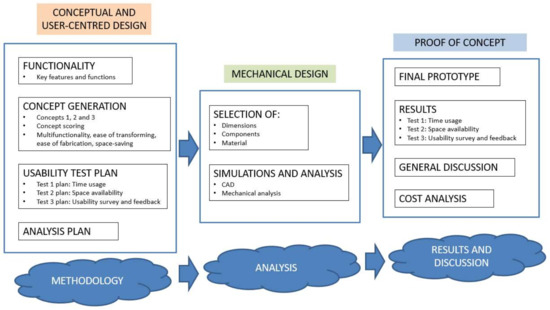
Figure 1.
Design process for the space-saving multipurpose table.
Functionality not only explores available features and functions in the market and scholarly literature, but also self-proposed features and functions from the authors’ perspective. Concept generation involves the proposal and selection of concepts based on criteria such as multifunctionality, ease of transforming, ease of fabrication and space-saving. A usability test plan is then proposed to evaluate the usability of the concept experimentally (time usage and space availability) and qualitatively (usability survey and feedback). An analysis plan is proposed to support the usability test plan.
Under mechanical design, the dimensions, material and components of the final concept are then established. CAD simulations and mechanical analysis are performed to verify whether the design is able to support a certain amount of load without failure. Finally, the the proof of the concept stage accounts for the presentation of the final prototype, test results, general discussion and cost analysis.
3.1. Functionality
Key Features and Functions
All the important features and functions are tabulated in Table 2. Apart from existing products and patents, functions that are self-proposed are included. The features and functions are further summarised in Table 3 by omitting similar features and functions from the previous list. These features and functions (labelled from A to M) are classified into foldable and multifunctional categories. This updated list is used as a reference in the proposal of several concepts, with each concept comprising one foldable attribute and several attributes related to multifunctionality.

Table 2.
List of features and functions from different sources.

Table 3.
Key features and functions by category.
3.2. Concept Generation
3.2.1. Concept 1
Combination: B + H + K. This concept presents a box-shaped table design that comprises two slots labelled A and B (See Figure 2). While primarily used as a table, this concept can be transformed into a chair by flipping the top section of the table surface so that it functions as a back rest. Slot A includes another foldable table that can be taken out to be used individually, while slot B acts as a storage compartment.
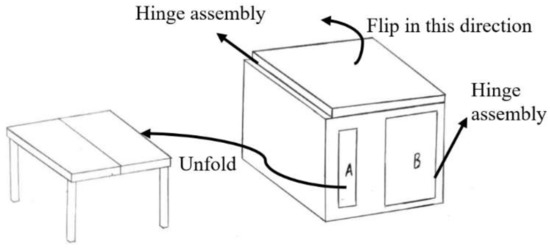
Figure 2.
Hand sketch of concept 1.
3.2.2. Concept 2
Combination: B + L. This concept presents a table design incorporated with the function of a ladder (See Figure 3). While it is primarily used as a table with foldable legs for ease of storage, it can also be used as a ladder. The ladder design can be observed on the other side of the table surface. To use the ladder, the table legs need to be folded inwards and the table surface needs to be folded in the middle for the ladder to stand on both sides.
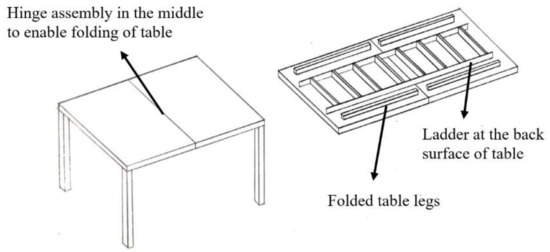
Figure 3.
Hand sketch of concept 2.
3.2.3. Concept 3
Combination: A + F + K+ M + N. This concept comprises a table design that combines the functions of a chair, stairs and rack (See Figure 4). This concept is primarily used as a table. The section labelled with A can be used as a rack to store stationery and books. By flipping one side of the table surface towards the direction of the rack and folding the legs of the flipped surface inwards, this concept can be transformed into a chair. By flipping the back rest and seat (which were both originally the table surface) in the same direction, the chair can be transformed into a stepladder.
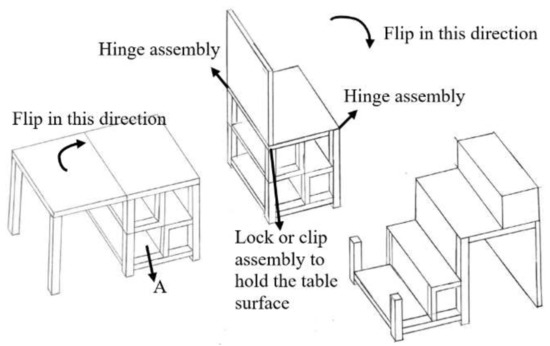
Figure 4.
Hand sketch of concept 3.
3.2.4. Concept Scoring
A concept scoring process is conducted to identify the final concept. Suitable criteria are given to conduct the scoring process. The scoring criteria for the concepts are justified as such:
- Multifunctionality: Since this study aims to develop a multifunctional table, multifunctionality is an important criterion. According to Yudina [50], multifunctionality is one of the future trends when it comes to the development of furniture. Therefore, it is important for this criterion to bear the highest weight in the scoring process.
- Ease of transforming: Since this study aims to develop a foldable table, the ease in the device’s transformation is a relevant and important criterion as well. According to Yudina [50], modern furniture designs are developed out of detailed work in maintaining the flexibility of space. The foldable aspect of the device would help maintain this flexibility of space, and therefore needs to be executed effectively and efficiently. Thus, the criterion regarding the flexibility, smoothness or ease of design transformation is important in this scoring process, and is also allocated with the highest weight of importance.
- Ease of fabrication: This criterion is concerned with the complexity of the design for the fabrication process. According to Donatello, et al. [51], there is a clear trend in the market that favours low-cost furniture which is mass produced. Since the complexity of furniture design affects the cost and efficiency of production, it is important to keep the design simple to ensure that the fabrication process is also simple. Therefore, the ease of fabrication is considered as a selection criterion for the scoring process.
- Space-saving: The prototype needs to be designed in such a way that it can be stored easily. According to Tan [52], space availability can be a major consideration in the design of furniture.
Table 4 shows that concept 3 attained the highest rank in the concept scoring process based on its dominance over the other concepts in criteria such as ease of transforming and multifunctionality. Therefore, concept 3 was selected as the final concept for this study.

Table 4.
Concept scoring.
3.3. Usability Test Plan
3.3.1. Test 1 Plan: Time Usage
For test 1 on time usage or efficiency, there are four scenarios created to test the invention. Each scenario is tested in two cases.
- Case A (control group): Test with 4 single-function furniture which include a table, a chair, a rack and a stepladder.
- Case B (test group): Test with the space-saving multipurpose table.
The time taken to complete the tasks in the scenarios using the single-function furniture (control group) is recorded and compared with the time taken to complete the tasks using the proposed invention (test group).
Figure 5 shows the illustration of the test scene. The test room contains two single-function pieces of furniture, namely the table and the rack. Room two is an additional room next to the test room where single-function furniture such as the stepladder and additional chair are placed. For all scenarios involving the control group, the proposed invention is also used as a single-function table with the condition that the proposed invention remains only in its table-transformed state.
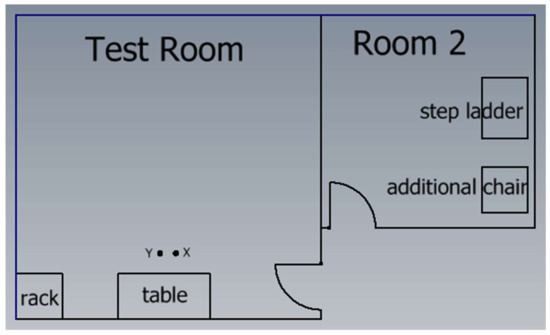
Figure 5.
Illustration of test scene.
Scenario 1
This scenario tests the combination of the table, rack and chair. The scenario is tested with the control group first. The following steps are adhered to in this scenario.
Control Group:
- The experimenter places a pen and paper on the single-function table in the test room.
- The participant assumes a seated posture at the table and gets ready to engage in a writing activity using the pen and paper placed on the single-function table.
- The timer starts the moment the participant commences writing a given message on the paper for 5 s.
- After completing the writing task, the participant is required to walk towards the single-function rack in the test room and place the paper in the rack.
- A guest is then invited by the participant to proceed with some discussion. In order to reduce bias, the same person is used as the guest for all scenarios wherever applicable.
- The participant needs to retrieve an additional single-function chair for the guest from Room two and place it on point X (see Figure 5).
- The timer stops after the guest has sat on the single-function chair for 3 s.
Test Group:
- Steps 1 to 5 are repeated with the same participant using the space-saving multipurpose table (test group).
- For the test group, instead of retrieving an additional chair for the guest in step 6, the participant converts the proposed invention from its table-transformed state into a chair.
- The timer for the test group stops when the guest sits on the chair for 3 s.
Scenario 2
This scenario tests the combination of the chair, rack and stepladder. The scenario is tested with the control group first. The following steps are adhered in this scenario.
Control Group:
- The timer starts the moment the participant retrieves a book from the single-function rack in the test room.
- The participant moves to the single-function chair situated at point X in the test room, and sits on it to read the book for 5 s.
- The participant moves to Room two to retrieve a single-function stepladder and place it on point Y.
- The participant moves up the single-function stepladder to retrieve something from a high place.
- The timer stops after the participant successfully comes down from the stepladder.
Test Group:
- The proposed invention is in its chair-transformed state at point X. A book is placed at the bottom rack of the chair.
- The timer starts the moment the same participant from the control group begins to retrieve a book from the bottom rack of the proposed invention which is in its chair-transformed state.
- The participant immediately sits on the proposed invention and reads the book for 5 s.
- Then, the participant moves the invention from point X to Y, and transforms the invention into a stepladder.
- The participant ascends the stepladder to retrieve something from a high place.
- The timer stops after the participant successfully comes down from the stepladder.
Scenario 3
This scenario tests the combination of the table, rack and stepladder. The scenario is tested with the control group first. The following steps are adhered in this scenario.
Control Group:
- Steps 1 to 4 from scenario 1 are repeated.
- Steps 3 to 5 from scenario 2 are repeated.
Test Group:
- Step 1 from in scenario 3 is repeated with the same participant using the proposed invention.
- Steps 9 to 11 from scenario 2 is repeated.
Scenario 4
This scenario tests the combination of the table, chair, rack and stepladder. The scenario is tested with the control group first. The following steps are adhered in this scenario.
Control Group:
- Steps 1 to 7 from scenario 1 are repeated (without the timer stopping at step 7).
- Steps 1 to 5 from scenario 2 are repeated (without the timer starting at step 1).
Test Group:
- Steps 8 to 10 from scenario 1 are repeated (without the timer stopping at step 10).
- Steps 6 to 11 from scenario 2 are repeated (without the timer starting at step 7).
3.3.2. Test 2 Plan: Space Availability
This test is done to compare the space occupied by the four single-function furniture pieces and the space-saving multipurpose table. All the single-function furniture items are arranged together in one space before the researcher proceeds with the dimension measurement of the occupied space. The proposed invention is placed at another space and the researchers measure the dimensions of the occupied space. The data are then recorded for comparison purposes.
3.3.3. Test 3 Plan: Usability Survey and Feedback
The participants involved in the usability experiments (test 1) also have to fill out a questionnaire consisting of variables such as ergonomic performance and space-saving effectiveness. The questionnaire items are adapted from Davis [53], while the items on space-saving effectiveness are adapted from Husein [54]. A seven-point Likert scale was administered for this study as it is more accurate, reliable, easier to use, and gives a better reflection of the respondent’s true evaluation in contrast to other Likert scales. The researchers also collected unstructured feedback from the participants about their responses to the survey.
All participants gave their written informed consent prior to the experiments. All procedures and protocols have been approved by the Research Ethics Committee (REC) from the Technology Transfer Office (TTO) of Multimedia University. The research ethics approval for the project has been granted with the approval number EA0042021, and the approval letter has been endorsed by the TTO Director cum REC Secretariat of the university.
3.4. Analysis Plan
The data in test 1 are analysed using Minitab version 19. The analyses include power analysis and paired-sample t-test. Test 2 data are analysed by comparing the space occupied using the single-function furniture with the space occupied using the proposed invention. Test 3 data are analysed using IBM SPSS Statistics version 21. The analyses include descriptive, reliability, normality and Spearman’s correlation analyses.
In test 1, all analyses done with the single-function furniture (control group) are categorised as Case A, while all analyses done with the proposed invention are categorised as Case B. Null and alternative hypotheses are proposed for each scenario comparing both cases A and B. If the p-value is found to be less than 0.05 (p < α), the null hypothesis is rejected and the alternate hypothesis is accepted. This outcome indicates that the time taken to complete the test for Case B is significantly shorter than Case A, which means that it is more efficient and time-saving to use the proposed invention as compared to using the single-function furniture. If the p-value is greater than 0.05 (p > α), the null hypothesis is accepted and the alternate hypothesis is rejected. This outcome indicates that there is no significant difference between the time taken to complete the test for Case A and Case B.
3.4.1. Test 1—Scenario 1 Hypotheses
With the significance value, α, set at 0.05, the hypotheses for test 1—scenario 1 are formulated as such:
- Null hypothesis, H01.1—There is no significant difference in the time to complete the tasks between Case A1 and Case B1.
- Alternative hypothesis, Ha1.1—There is a significant difference in the time to complete the tasks between Case A1 and Case B1.
3.4.2. Test 1—Scenario 2 Hypotheses
With the significance value, α, set at 0.05, the hypotheses for test 1—scenario 2 are formulated as such:
- Null hypothesis, H01.2—There is no significant difference in the time to complete the tasks between Case A2 and Case B2.
- Alternative hypothesis, Ha1.2—There is a significant difference in the time to complete the tasks between Case A2 and Case B2.
3.4.3. Test 1—Scenario 3 Hypotheses
With the significance value, α, set at 0.05, the hypotheses for test 1—scenario 3 are formulated as such:
- Null hypothesis, H01.3—There is no significant difference in the time to complete the tasks between Case A3 and Case B3.
- Alternative hypothesis, Ha1.3—There is a significant difference in the time to complete the tasks between Case A3 and Case B3.
3.4.4. Test 1—Scenario 4 Hypotheses
With the significance value, α, set at 0.05, the hypotheses for test 1—scenario 4 are formulated as such:
- Null hypothesis, H01.4—There is no significant difference in the time to complete the tasks between Case A4 and Case B4.
- Alternative hypothesis, Ha1.4—There is a significant difference in the time to complete the tasks between Case A4 and Case B4.
4. Analysis
4.1. Table Dimensions
For this study, it is important that the table is designed with a low height so that it complements the chair design. Therefore, the dimensions of a common chair are referenced as well.
Table 5 shows the dimensions of a commonly-used table and chair in the market. The ranges for table dimensions include 100 to 107 cm in length, 60 to 76 cm in width and 75 to 80 cm in height [55,56]. The ranges for chair dimensions include 46 to 52 cm in length, 42 to 51 cm in width and 80 to 84 cm in height [57,58]. The researcher decided that the final dimensions of the foldable and multifunctional table should be set at 84 cm × 45 cm × 44 cm (length × width × height). The height is taken as 44 cm because when a chair’s function is referenced, the seat height ranges from 44 cm to 47 cm. The dimensions of the actual prototype may differ slightly (by 1 to 2 cm) due to the application of hinges.

Table 5.
Dimensions of existing tables and chairs in the market.
4.2. Component Selection: Hinge
There are several types of hinges used in the industry. Some potential hinge choices for foldable and/or multifunctional furniture include the butt, side and corner hinges. The butt hinge is normally used for door frames that have a wide opening range. The side hinge is normally used for boxes. The corner hinge is used on entry and interior doors, cabinets and furniture [59].
Table 6 shows the scoring results for the hinge choices according to criteria such as opening range, durability, stability, cost and load capacity. The butt hinge scored the highest among the other hinges and is selected for this study. The scoring criteria for the hinges are described as such:

Table 6.
Scoring of hinges.
- Open range: This criterion indicates the usability of the hinge, which includes determining the opening width of the hinge.
- Durability: This criterion checks the robustness of the hinge through its characteristics.
- Stability: This criterion indicates the steadiness of the connection when the hinge is in operation.
- Cost: This criterion focusses on the extent of cost for mass production.
- Load capacity: This criterion looks into the weight that the hinge can withstand to maintain its durability.
4.3. Material Selection
Table 7 shows the types of wood selected for comparison and scoring. The wood type shown in the table includes oak, maple, nyatoh, walnut and ash wood. Each type has an ultimate tensile strength that can potentially withstand a certain level of force acting perpendicularly to the grain of the wood [60].

Table 7.
Ultimate tensile strength of each type of wood.
Table 8 shows the wood scoring results according to the criteria of weight, durability, moisture resistance, cost, ease of fabrication, comfortability and availability. The results show that oak wood scored the highest with a score of 3.65, followed by nyatoh wood with the second highest score of 3.55. However, due to the unavailability of oak wood at the supplier’s end during the point of time in the project, the researcher decided to select nyatoh wood as the alternative material for the structure since nyatoh wood has an ultimate tensile strength that is comparable to the tensile strength of oak wood.

Table 8.
Scoring of wood.
4.4. Simulations and Analysis
Simulations and analyses are performed on the proposed invention in its transformed states (table, chair and stepladder modes). The simulation is done using Autodesk Inventor Professional 2019. The results from the simulation are compared with the results from the mechanical analysis.
According to Tunay and Melemez [36], males have an average weight of 69.50 kg and females have an average weight of 56.02 kg. One way of conducting the simulation is to assume an average applied load of 70 kg acting on the device to be consistent with the above-mentioned requirement. However, a simulation that is solely based on average weight may not be sufficient because furniture should be designed to withstand a large force or maximum weight. A common chair can usually withstand a weight of 120 kg. Thus, the weight of 120 kg is also used in this simulation as the maximum weight.
4.4.1. CAD Simulation Results
Technically, there is no significance in applying the loads of 70 kg and 120 kg on the invention in its table-transformed state because in reality, the possibility of such loads being applied on the table might be low. However, in order to simulate for the worst-case scenario, the analyses on the table using 70 kg and 120 kg of weights are still carried out. The worst-case scenario could assume that users may place very heavy items on the table surface while using the table to support their upper limb, thus applying the weight of their upper extremity on the table as well. Figure 6 shows the overview of the force applied on the table, specifically in the middle of the table surface.
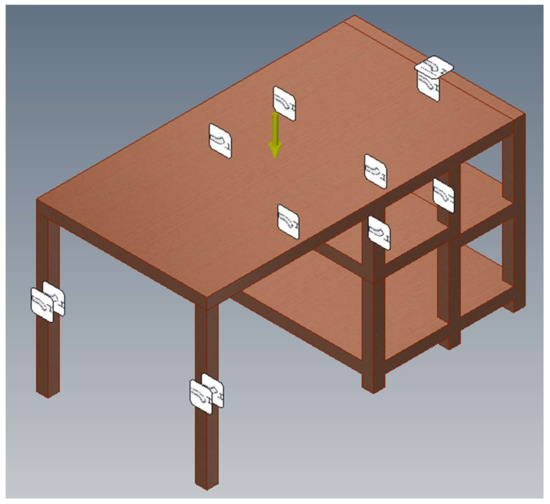
Figure 6.
Overview of force applied on table.
The simulation results for the von Mises stress and displacement of the table are shown in Figure 7. The maximum stress occurs at the table edge and top surface of the table leg. The stress ranges from 0.2165 to 0.4331 MPa for a simulation with 70 kg, and 0.3712 to 0.7424 MPa for a simulation with 120 kg. These findings indicate that the stresses do not exceed the ultimate tensile strength of the material, which is 5.1 MPa. For displacement results, a maximum deformation of 0.02419 mm is found for the 70-kg simulation. A deformation of 0.04146 mm is found for the 120-kg simulation. These results indicate that the displacements can be neglected since the maximum deformations are small in comparison to the size of the prototype.
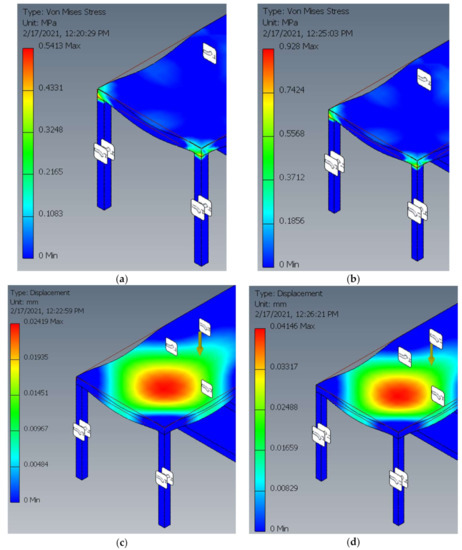
Figure 7.
Von Mises stress and displacement simulation results for invention in table-transformed state when applying weights of 70 kg and 120 kg. (a) Von Mises stress simulation for 70 kg, (b) Von Mises stress simulation for 120 kg, (c) Displacement simulation for 70 kg, (d) Displacement simulation for 120 kg.
Figure 8 shows the overview of the force applied on the chair, specifically in the middle of the chair seat.
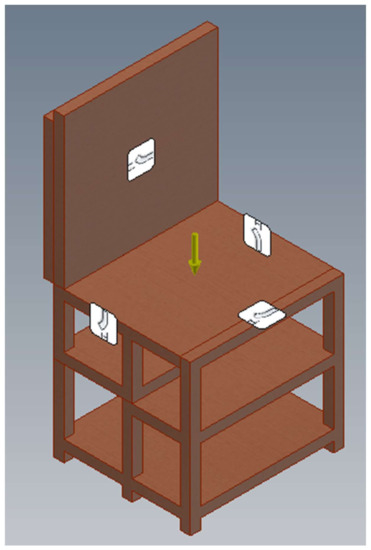
Figure 8.
Overview of force applied on chair.
The simulation results for the von Mises stress and displacement of the chair are shown in Figure 9. The maximum stress occurs at the joint where the chair seat is flipped at a 90-degree angle to be transformed from a table to a chair. The stress ranges from 0.1206 MPa to 0.1507 MPa for the 70-kg simulation, and 0.2067 MPa to 0.2584 MPa for the 120-kg simulation. These stresses do not exceed the ultimate tensile strength of the material, which is 5.1 MPa. There is a maximum deformation of 0.006027 mm with the 70-kg simulation and a deformation of 0.01033 mm with the 120-kg simulation. These results are negligible since the maximum deformations are small in comparison with the size of the prototype.
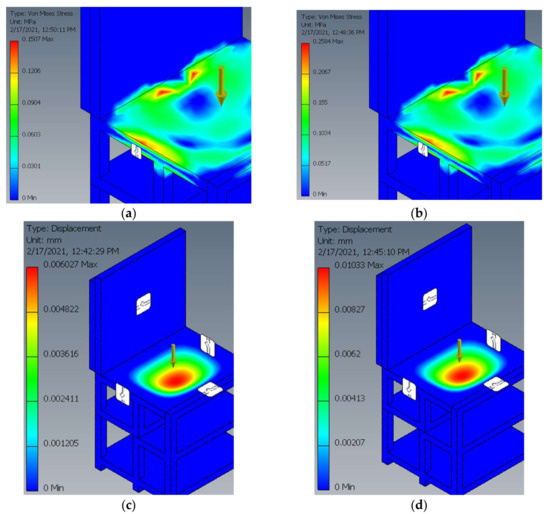
Figure 9.
Von Mises stress and displacement simulation results for invention in chair-transformed state when applying weights of 70 kg and 120 kg. (a) Von Mises stress simulation for 70 kg, (b) Von Mises stress simulation for 120 kg, (c) Displacement simulation for 70 kg, (d) Displacement simulation for 120 kg.
Figure 10 shows the overview of the force applied on the stepladder, specifically in the middle of the stepped areas.
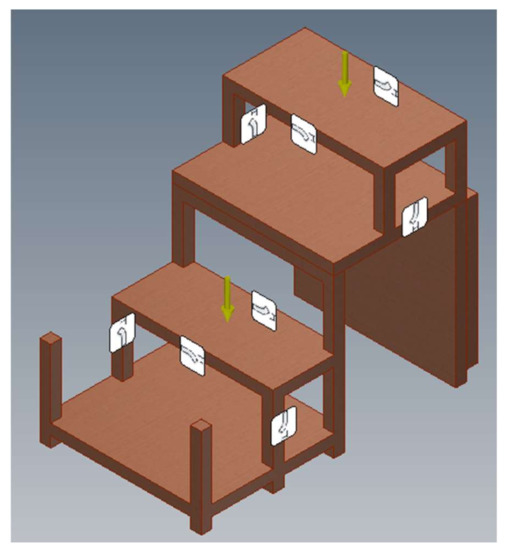
Figure 10.
Overview of force applied on stepladder.
The simulation results for the von Mises stress and displacement of the chair are shown in Figure 11. The maximum stress occurs towards the side of the stepped area’s surface. The stress ranges from 0.03434 MPa to 0.06868 MPa for the 70-kg simulation, and 0.0589 MPa to 0.1177 MPa for the 120-kg simulation. These stresses do not exceed the ultimate tensile strength of the material, which is 5.1 MPa. The displacement results show a maximum deformation of 0.001307 mm for the 70-kg simulation and a deformation of 0.00224 mm for a 120-kg simulation. These displacements are neglected because the maximum deformation is small in comparison with the size of the prototype.
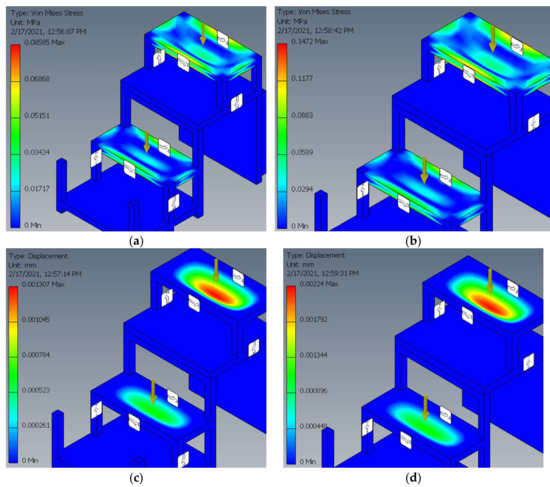
Figure 11.
Von Mises stress and displacement simulation results for invention in stepladder-transformed state when applying weights of 70 kg and 120 kg. (a) Von Mises stress simulation for 70 kg, (b) Von Mises stress simulation for 120 kg, (c) Displacement simulation for 70 kg, (d) Displacement simulation for 120 kg.
4.4.2. Mechanical Analysis
Figure 12 shows the free body diagrams of the table surface, chair and stepladder. Figure 13 shows the diagram of the moment of inertia. The load is assumed to be distributed uniformly on the table, chair and stepladder. A maximum load of 120 kg is applied for all the analyses. Similar to the previous reasoning for the simulation, there is technically no significance in applying the load of 120 kg on the table because in reality, the possibility of such a load being applied on the table might be low. However, in order to simulate for the worst-case scenario, the analysis on the table using 120 kg of weight is still carried out. The worst-case scenario could assume that users may place very heavy items on the table surface while using the table to support their upper limb, thus applying the weight of their upper extremity on the table as well. By using Equations (1) and (2), the maximum deformation for the table, chair and stepladder are obtained. By using Equations (3) and (4), the moment of inertia and distributed load are obtained for the calculation of the maximum deformation.
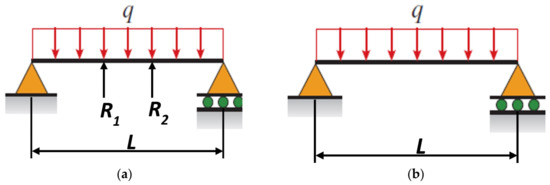
Figure 12.
Free body diagrams of the invention. (a) Table, (b) Chair and stepladder.

Figure 13.
Diagram of moment of inertia.
Table 9 shows the measurement parameters of the table, chair and stepladder. The results of the maximum deformations are tabulated in Table 10. While the maximum deformations are higher than the ones produced from the simulations, the deformations are still small in comparison to the size of the prototype. Thus, the deformations can be neglected.

Table 9.
Parameter values.

Table 10.
Results of maximum deformations.
5. Results and Discussion
5.1. Final Prototype
The final prototype is designed with the functions of a table, chair, rack and stepladder. Figure 14, Figure 15 and Figure 16 show all three transformations of the final prototype with the rack function embedded in each function.
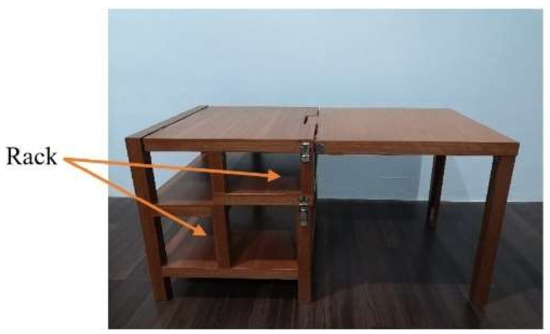
Figure 14.
Final prototype—table mode.
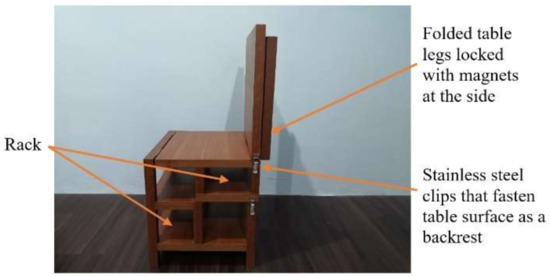
Figure 15.
Final prototype—chair mode.
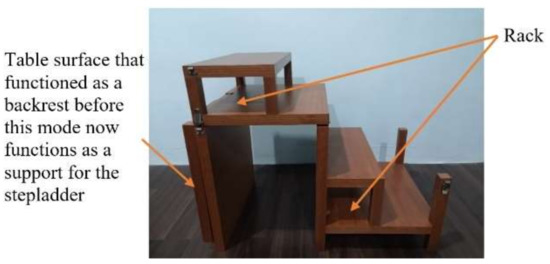
Figure 16.
Final prototype—stepladder mode.
In order to transform into a chair, the prototype’s table surface at one side is lifted and fastened with a locking hinge mechanism to be transformed into a backrest. The table legs at the lifted surface are folded and locked with magnets at the side (see Figure 15).
In order for the prototype to transform into a stepladder, the locking mechanism at the lower half of the chair’s legs is released so that the entire chair seat and backrest can be flipped to form a stepladder design (see Figure 16).
Figure 17 visualises the step-by-step operation for the space-saving multipurpose table. The following descriptions highlight the steps of the operation.
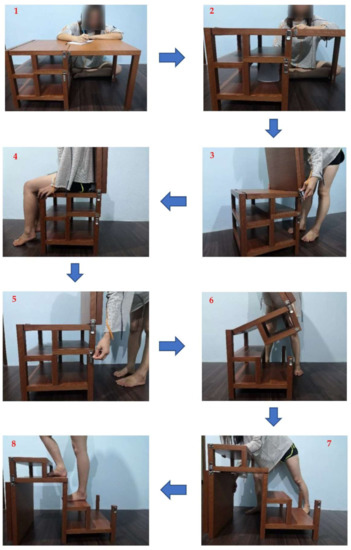
Figure 17.
Step-by-step operation for the space-saving multipurpose table.
- The user performs a writing task on the device in its table mode.
- The written material is kept in the rack located below the surface of the table.
- The table is transformed into a chair through the use of a butt hinge in the middle of the table which allows one side of the table top to be flipped. The table legs on the flipped surface are folded through the use of butt hinges too, and locked at the side with magnets. The flipped surface is fastened with stainless steel clips on both sides.
- The user sits on the device in its chair mode.
- The stainless-steel clips at the lower half of the chair legs are unfastened in order to switch the chair into its stepladder mode.
- The lower half of the chair legs is unlocked and flipped to the user’s right side.
- The chair’s backrest faces downwards and acts as a support for the stepladder, and the rack is divided into two smaller compartments at the top and bottom of the stepladder.
- The user can now ascend the stepladder.
5.2. Results for Test 1: Time Usage
A total of six users participated in this test. Test 1 compares the time taken to complete certain tasks using single-function furniture and the proposed invention. Each user repeated the experiment of every scenario a total of five times.
The Ryan-Joiner test of normality is used to inspect the normality of the data. The test of normality confirmed that the distribution of the data does not significantly differ from being symmetric (p > 0.05). Hence, the dataset is appropriate for further parametric tests.
5.2.1. Power Analysis and Sample Size Estimation
A power analysis for the paired sample t-test is done for all the cases with a statistical power set at 80% to predict the actual sample size needed for the experiments. Before proceeding with the power analysis, the mean, standard deviation, mean difference and pooled standard deviation are calculated as shown in Equations (5) to (8). The preceding parameters are used to compute Cohen’s d.
Note: xi—total time taken to complete the test for case A or B in each scenario
n—number of samples
M1—mean value of time taken for case A in each scenario
M2—mean value of time taken for case B in each scenario
—standard deviation of time taken for case A in each scenario
—standard deviation of time taken for case B in each scenario
Cohen’s d is an effect size used to indicate the standardised difference between two means. Equation (9) is used to compute Cohen’s d.
Using the power and sample size estimator in Minitab version 19, the predicted sample sizes for all the cases are computed. Table 11 shows the parameter calculation results used to compute Cohen’s d. Table 12 shows the results of predicted sample sizes for all the cases. Based on the actual statistical power and adherence of the normality assumption, the current sample size of six participants used to produce the datasets for all the scenarios is found to be sufficient and well above 80%. Thus, the study proceeded with the paired sample t-test.

Table 11.
Updated parameters used for Cohen’s d.

Table 12.
Updated results of power and sample size estimation.
5.2.2. Paired Sample t-Test
Scenario 1
Table 13 shows the results of the paired sample t-test for scenario 1. It is found that the two groups differed significantly from each other [t(4) = 17.53, p < 0.05], with samples from Case B1 achieving a lower completion time than samples from Case A1 (MB1 = 18.662 s, MA1 = 25.996 s). Therefore, Ha1.1 is accepted.

Table 13.
Results of the paired sample t-test for scenario 1.
Scenario 2
Table 14 shows the results of the paired sample t-test for scenario 2. It is found that the two groups differed significantly from each other [t(4) = 22.50, p < 0.05], with samples from Case B2 achieving a lower completion time than samples from Case A2 (MB2 = 19.985 s, MA2 = 26.889 s). Therefore, Ha1.2 is accepted.

Table 14.
Results of the paired sample t-test for scenario 2.
Scenario 3
Table 15 shows the results of the paired sample t-test for scenario 3. It is found that the two groups differed significantly from each other [t(4) = 16.83 p < 0.05], with samples from Case B3 achieving a lower completion time than samples from Case A3 (MB3 = 24.476 s, MA3 = 27.891 s). Therefore, Ha1.3 is accepted.

Table 15.
Results of the paired sample t-test for scenario 3.
Scenario 4
Table 16 shows the results of the paired sample t-test for scenario 4. It is found that the two groups differed significantly from each other [t(4) = 86.84 p < 0.05], with samples from Case B4 achieving a lower completion time than samples from Case A4 (MB4 = 30.818 s, MA4 = 45.209 s). Therefore, Ha1.4 is accepted.

Table 16.
Results of the paired sample t-test for scenario 4.
5.3. Results for Test 2: Space Availability
Table 17 shows the results for test 2, which involves measuring the single-function furniture dimensions and the proposed prototype dimensions (in cm) with the sequence of length, width and height (L × W × H). The arrangements of the single-function furniture and the proposed prototype are shown in Figure 18 and Figure 19. The storage space required for the arrangement of the single function furniture is 196 × 60 × 126 cm, which is larger than the storage space required for the space-saving multipurpose table (85 × 45 × 44 cm).

Table 17.
Dimension measurement results.
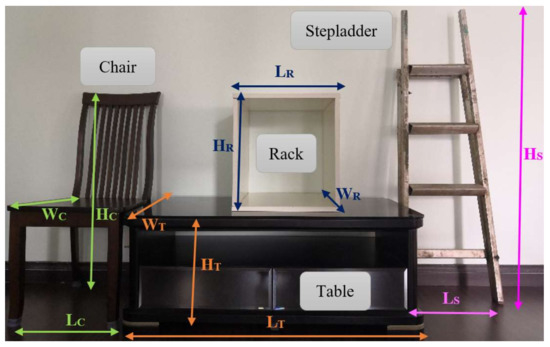
Figure 18.
Dimension measurement of single-function furniture. Notes: LC—Length of chair; WC—Width of chair; HC—Height of chair; LT—Length of table; WT—Width of table; HT—Height of table; LR—Length of rack; WR—Width of rack; HR—Height of rack; LS—Length of stepladder; HS—Height of stepladder.
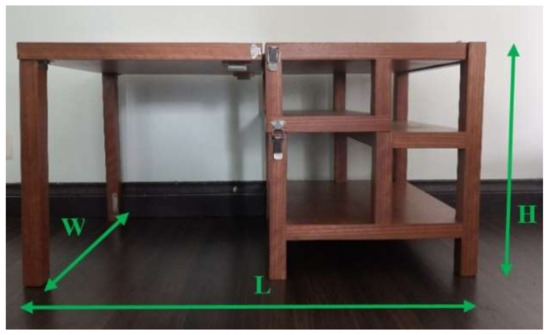
Figure 19.
Dimension measurement of the space-saving multipurpose table. Notes: L—Length of table; W—Width of table; H—Height of table.
5.4. Results for Test 3: Usability Survey and Feedback
5.4.1. Descriptive Analysis
According to the demographics reported in Table 18, the participants were mostly 20 to 21 years of age (about 67%). Males and females equally accounted for 50% of the total population sampled. Approximately 58% of the participants agreed that the proposed invention performed well ergonomically. Around 42% of the participants strongly agreed that the invention is ergonomic. The majority of the participants (about 77%) were agreeable that the device has effective space-saving attributes, while the remaining participants strongly agreed.

Table 18.
Participant demographics by age and gender.
5.4.2. Reliability and Normality Analysis
The reliability of the survey instrument was evaluated using the Cronbach’s alpha coefficient. From Table 19, the alpha values suggested that the internal consistency of the survey instrument was acceptable (α > 0.6) for all the variables.

Table 19.
Cronbach’s alpha values for survey instrument.
Based on Table 20, the Shapiro-Wilk and Kolmogorov-Smirnov tests of normality confirmed that the distribution of the questionnaire data does not significantly differ from being symmetric (p > 0.05). A non-parametric analysis known as the Spearman’s rank correlation test was used to analyse the data. This test measures the strength and direction of association between two ranked variables. The full distribution of Spearman’s rho is derived for small samples and would be suitable for the survey data analysis of this study.

Table 20.
Kolmogorov-Smirnov and Shapiro-Wilk tests of normality.
Based on Table 21, it was found that space-saving effectiveness strongly, positively and significantly correlated with ergonomic performance (rs = 0.851, p < 0.05).

Table 21.
Correlation between space-saving effectiveness and ergonomic performance.
5.4.3. Unstructured Feedback
Table 22 shows the summary of results from the unstructured feedback obtained from participants of the experiment and survey. Based on the feedback, the participants agreed that the proposed invention demonstrated excellent functionality and stability in all the intended functions. Apart from occupying less storage and functional space, the transformation process of the proposed invention was also smooth. However, it was also highlighted that the table was slightly heavy and its height was rather low. In addition, the storage rack was small and not entirely covered.

Table 22.
Summary of unstructured feedback results.
5.5. General Discussion
The usability survey analysis found that space-saving effectiveness strongly, positively and significantly correlated with ergonomic performance. This finding implied that as the space-saving attribute of the device improves, it is perceived to perform more ergonomically. This finding can be associated with the findings of Yudina [50], who mentioned that maintaining the flexibility of a space requires designs to deliver their functionality while preserving abundant room for future change. Therefore, the space sustainability and multifunctionality aspects should be included for furniture and product design. Such designs would assist users in carrying out multiple activities effectively and simultaneously within limited spaces.
The survey results support the experimental results of test 2. The proposed invention occupies a space of 85 × 45 × 44 cm which is much less than the space taken up by the single-function furniture (196 × 60 × 126 cm). This finding infers that the proposed invention can be suitable for modern day home furnishing which comprises transformable tables, chairs and beds [52]. Due to cost and space limitations, multifunctional aspects in furniture are more desirable than opting for additional furniture. Kaprol [61] concurred that such aspects in furniture designs are suitable for those with restricted budgets. The above-mentioned substantiations also triangulated well with the participant feedback results which supported aspects pertaining to the functionality, stability, transformation process and space-saving attributes demonstrated by the proposed invention.
In test 1, the efficiency of using the proposed invention was assessed. The results showed that the participants were able to perform tasks much faster with the proposed invention than with the single-function furniture. In principle, the time saved when using a certain product can be attributed to the product’s usefulness as well. From the survey analyses, usefulness is one of the major aspects observed in ergonomic performance. This relation indicates that the foldable and multifunctional table is ergonomic in regard to usage time and can potentially simplify the user’s work wherever applicable.
5.6. Cost Analysis
Table 23 shows the material costs needed to produce one unit of the space-saving multipurpose table. The sales cost per unit is estimated at 600 MYR (about 40% higher than the material cost for a single unit). The estimated fixed cost for each expenditure is tabulated in Table 24.

Table 23.
Material cost for a single space-saving multipurpose table.

Table 24.
Estimated fixed expenses per month.
These data are inserted into Excel for the break-even quantity analysis using Equation (10). A break-even analysis chart is plotted with the break-even units shown in Figure 20. Based on the chart, profit is possible if the sales exceeded 40 units. This sales target is reasonably achievable seeing as most multifunctional furniture are priced at the range of 1000 to 2000 MYR. Furthermore, it is anticipated that the material costs per unit can be reduced from bulk purchasing, thus further increasing chances to surpass the break-even quantity more rapidly.
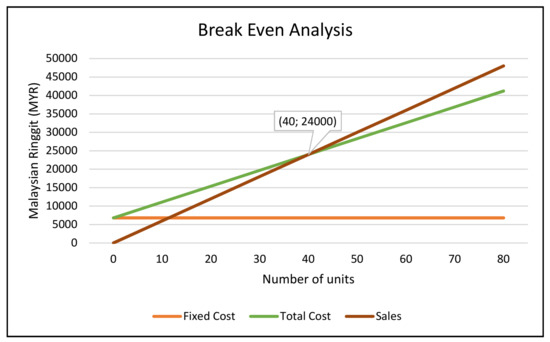
Figure 20.
Break-even analysis chart.
Notes: Fc—Fixed expenses per month
Sp—Sales price per unit
VC—Variable cost per unit
6. Conclusions
The aim of this study was to develop a space-saving multipurpose table for improved ergonomic performance. This aim was achieved by investigating variants of foldable and multifunctional tables through reviews of patents and scholarly literature. The conceptualisation, material selection, component selection, analyses, fabrication and testing of the invention also contributed to the achievement of this aim.
6.1. Key Findings Based on Research Questions
6.1.1. RQ1: Improved Multifunctionality and Space-Saving Characteristics
Multifunctionality: The proposed invention was conceptualised and designed to support four functions, namely the table, chair, rack and stepladder functions. Existing multifunctional tables commonly possess two functions. Hence, the proposed invention presents improved universality.
Reduction of space usage: After measuring the dimensions of both the proposed invention and the single-function furniture, it was found that the proposed invention occupied about 25 to 80% less space than the single-function furniture. Thus, the proposed invention has the capacity to reduce space usage.
6.1.2. RQ2: Proof of Concept and Ergonomic Performance
Reduction of time during the operation: The proposed invention was designed to perform its transformations by flipping specific sections. With the aid of hinges, the device was able to transform easily and smoothly. The results showed that participants performed tasks 1.1 to 1.5 times faster with the proposed invention than with the single-function furniture. Hence, the operation time was reduced with the proposed invention, and a proof of concept was established with regard to its feasibility and function.
Ergonomic performance: There was a strong, positive and significant correlation between the space-saving effectiveness of the proposed table and ergonomic performance, with favourable feedback on the invention’s functionality, stability, transformation process, and ability to save space.
6.2. Limitations of the Study
Several limitations were found after the prototype was fabricated. Some of the limitations were collected from the participants’ opinions during the unstructured feedback session, while other limitations were observed during the tests.
The limitations from the feedback included the low table height and heaviness of the table. The height of the table (which followed the height of the chair seat) was considered lower than many other domestic tables. Hence, the generalisability of its functionality may be limited to tables of a similar height. Since nyatoh wood was used for the fabrication, the table ended up being heavy. Due to the time constraint of the project, it was also not possible to improve the design of the rack, which was small and not covered.
Although the statistical power was well above 80%, the number of participants for each experiment was still considered low. While the analyses may be sufficient for a proof of concept, it is uncertain if the level of reliability for each experiment can be emulated with a much larger sample size for potential commercial transition.
The final limitation involved the tests. The proposed invention was designed for domestic purposes. While the activities in the tests are considered domestic, the tests were carried out only for indoor situations. Furthermore, the test was conducted only among young adults between the ages of 20 to 23. The outcome of the results might be different if the experiments accounted for outdoor domestic activities and different age categories.
6.3. Recommendations for Future Research
One of the recommendations includes reducing the weight of the proposed invention. More studies could be reviewed in the future, especially on the material used to fabricate lightweight furniture. The selection of the test subjects can be broadened as well by including participants with different occupations such as housewives, technicians and elementary students. These inclusions would allow the researcher to observe the table’s extent of applicability and suitability. Lastly, the tests could include outdoor domestic activities to evaluate the efficacy of the space-saving multipurpose table in a different domestic context.
Author Contributions
Conceptualization, H.Y.C., P.K.N., R.J.N., A.S., Y.J.N. and K.Y.N.; Data curation, H.Y.C. and P.K.N.; Formal analysis, H.Y.C. and P.K.N.; Funding acquisition, P.K.N.; Investigation, H.Y.C., P.K.N., R.J.N., A.S., Y.J.N. and J.A.Y.; Methodology, H.Y.C., P.K.N., R.J.N. and A.S.; Project administration, P.K.N., R.J.N. and J.A.Y.; Software, H.Y.C. and P.K.N.; Supervision, P.K.N.; Validation, H.Y.C.; Writing—original draft, H.Y.C. and P.K.N.; Writing—review & editing, H.Y.C., P.K.N., R.J.N., A.S., Y.J.N., J.A.Y. and K.Y.N. All authors have read and agreed to the published version of the manuscript.
Funding
The article processing charge for this manuscript is supported by Multimedia University (Reference ID: MMU/RMC/PC/2021/49410).
Institutional Review Board Statement
The study was conducted according to the guidelines of the Declaration of Helsinki. All participants gave their written informed consent prior to the experiments. All procedures and protocols have been approved by the Research Ethics Committee (REC) from the Technology Transfer Office (TTO) of Multimedia University. The research ethics approval for the project has been granted with the approval number EA0042021, and the approval letter has been endorsed by the TTO Director cum REC Secretariat of the university.
Informed Consent Statement
Informed consent was obtained from all subjects involved in the study.
Data Availability Statement
This project contains the following underlying data: Data Availability Sheet.docx (dataset for tests and surveys done with the space-saving multipurpose table). The data can be found at Figshare: doi.org/10.6084/m9.figshare.16770895. Data are available under the terms of the Creative Commons Attribution 4.0 International license (CC-BY 4.0).
Acknowledgments
This study was part of the main author’s final year project for his B.Eng. (Hons) Mechanical degree. The researchers would like to thank the Faculty of Engineering and Technology, Multimedia University (MMU), for allowing this study to be carried out. The researchers would also like to thank Norhidayah Mohamad for providing some useful comments during the main author’s project presentation. Special thanks go to the Research Ethics Committee and Technology Transfer Office members of MMU for granting the researchers with ethical clearance to conduct this study. Lastly, the researchers are exceptionally grateful to Chiew Fen Ng for her constructive criticism of the manuscript.
Conflicts of Interest
No potential conflict of interest were reported by the authors.
References
- Du, T.; Jansen, S.; Turrin, M.; van den Dobbelsteen, A. Effects of Architectural Space Layouts on Energy Performance: A Review. Sustainability 2020, 12, 1829. [Google Scholar] [CrossRef]
- Xu, X.; Luo, F.; Wang, W.; Hong, T.; Fu, X. Performance-Based Evaluation of Courtyard Design in China’s Cold-Winter Hot-Summer Climate Regions. Sustainability 2018, 10, 3950. [Google Scholar] [CrossRef]
- Boeckermann, L.M.; Kaczynski, A.T.; King, S.B. Dreaming big and living small: Examining motivations and satisfaction in tiny house living. J. Hous. Built Environ. 2019, 34, 61–71. [Google Scholar] [CrossRef]
- Brandenburg, E.v. “Small Is Beautiful” or How to Redefine Good Life: Tiny Homes in Finland. Master’s Thesis, Jyväskylä University, Jyväskylä, Finland, 2020. [Google Scholar]
- Barbosa, J.A.; Araújo, C.; Mateus, R.; Bragança, L. Smart interior design of buildings and its relationship to land use. Archit. Eng. Des. Manag. 2016, 12, 97–106. [Google Scholar] [CrossRef][Green Version]
- Das, S.; Rijas, M.P.; Das, A.K. DOT: Design of a Space-Saving Furniture with Prototype-Driven Innovation Approach. In Research into Design for a Connected World. Smart Innovation, Systems and Technologies; Chakrabarti, A., Ed.; Springer: Singapore, 2019; Volume 134, pp. 745–755. [Google Scholar]
- Lim, S.H.; Ng, P.K. Design and Development of a Foldable Wheelchair Stretcher. Inventions 2021, 6, 35. [Google Scholar] [CrossRef]
- Rajan, A.R.P.; Elavarasan, D.; Balaji, S.; Dinesh, A.; Gowtham, K. Design and Fabrication of Multifunctional Furniture. Int. J. Res. Eng. Sci. Manag. 2019, 2, 442–447. [Google Scholar]
- Liu, Y. A study on the shape design of the folding table. Adv. Mater. Res. 2014, 933, 619–622. [Google Scholar] [CrossRef]
- Astonkar, D.V.; Kherde, S.M. Design and development of multipurpose, space saving seating arrangements using ergonomics. Int. J. Eng. Res. Appl. 2015, 7–12. Available online: https://www.ijera.com/special_issue/NCERT-Nov-2015/0712.pdf (accessed on 4 July 2021).
- Varghese, E.; Kumar, S.; Lohit, H.S. Design of Multipurpose Modular, Flexible and Space-Saving Dining Table. SAS TECH 2011, 10, 103–111. [Google Scholar]
- Lins, P.S.; Cunha, R.D.A.; Kiperstok, A.; Rapôso, Á.L.Q.R.e.S.; César, S.F. Opportunities for Cleaner Production (CP) Using Process Flow Analysis: Case Study of a Furniture Manufacturer in the City of Palhoça (SC, Brazil). Sustainability 2020, 12, 863. [Google Scholar] [CrossRef]
- Andrews, J. Nine Million Tons of Furniture Go to Landfills Every Year. This Company Has a Better Plan. Available online: https://archive.curbed.com/2019/4/11/18303532/furniture-waste-green-standards-landfill-recycling (accessed on 1 August 2021).
- Lim, S.H.; Ng, P.K. Synthesisation of design features for multifunctional stretcher concepts. J. Med Eng. Technol. 2021, 45, 145–157. [Google Scholar] [CrossRef]
- Uysal, M. Furniture Design and Product Development Principles Considering End-of-life Options and Design for Environment Strategies. Master’s Thesis, Purdue University, West Lafayette, IN, USA, 2014. [Google Scholar]
- Bonvoisin, J.; Halstenberg, F.; Buchert, T.; Stark, R. A systematic literature review on modular product design. J. Eng. Des. 2016, 27, 488–514. [Google Scholar] [CrossRef]
- Cuerdo-Vilches, T.; Navas-Martín, M.Á.; Oteiza, I. Working from Home: Is Our housing Ready? Int. J. Environ. Res. Public Health 2021, 18, 7329. [Google Scholar] [CrossRef]
- Dayakar, B.; Chopra, S. Transformable Space Saving Furniture. J. Emerg. Technol. Innov. Res. 2020, 7, 2062–2065. [Google Scholar]
- Kwon, H.; Kim, S. Characteristics of Residential Space in Response to Changed Lifestyles: Focusing on the Characteristics of Residents and the Relationship between Individual and Family. Sustainability 2019, 11, 2006. [Google Scholar] [CrossRef]
- Pirc Barčić, A.; Kitek Kuzman, M.; Vergot, T.; Grošelj, P. Monitoring Consumer Purchasing Behavior for Wood Furniture before and during the COVID-19 Pandemic. Forests 2021, 12, 873. [Google Scholar] [CrossRef]
- Raaij, W.F.V. Understanding Consumer Financial Behavior: Money Management in an Age of Financial Illiteracy, 1st ed.; Palgrave Macmillan: London, UK, 2016. [Google Scholar]
- Kotler, P. Marketing Management, Analysis, Planning, Implementation and Control, 8th ed.; Prentice Hall: Upper Saddle River, NJ, USA, 1991. [Google Scholar]
- Høibø, O.; Hansen, E.; Nybakk, E.; Nygaard, M. Preferences for Urban Building Materials: Does Building Culture Background Matter? Forests 2018, 9, 504. [Google Scholar] [CrossRef]
- Dhar, R. Consumer Preference for a No-Choice Option. J. Consum. Res. 1997, 24, 215–231. [Google Scholar] [CrossRef]
- Oblak, L.; Glavonjić, B.; Pirc Barčić, A.; Bizjak Govedič, T.; Grošelj, P. Preferences of Different Target Groups of Consumers in Case of Furniture Purchase. Drv. Ind. 2020, 71, 79–87. [Google Scholar] [CrossRef]
- Bumgardner, M.S.; Nicholls, D.L. Sustainable Practices in Furniture Design: A Literature Study on Customization, Biomimicry, Competitiveness, and Product Communication. Forests 2020, 11, 1277. [Google Scholar] [CrossRef]
- Li, H.; Hu, R.; Alhashim, I.; Zhang, H. Foldabilizing furniture. ACM Trans. Graph. 2015, 34, 90. [Google Scholar] [CrossRef]
- Mollerup, P. Collapsible: The Genius of Space-Saving Design Paperback, 1st ed.; Chronicle Books: San Francisco, CA, USA, 2001. [Google Scholar]
- Caballer, M. Design of an adjustable table. Bachelor’s Thesis, Jönköping University, Jönköping, Sweden, 2016. [Google Scholar]
- Zhou, J.; Chen, X. Convertible furniture design. Comput. Graph. 2018, 70, 165–175. [Google Scholar] [CrossRef]
- Knauf, M. Understanding the consumer: Multi-modal market research on consumer attitudes in Germany towards lightweight furniture and lightweight materials in furniture design. Eur. J. Wood Wood Prod. 2015, 73, 259–270. [Google Scholar] [CrossRef]
- Estrada, R.D.; Wyller, M.; Dahy, H. Aerochair Integrative design methodologies for lightweight carbon fiber furniture design. In Proceedings of 37 eCAADe and XXIII SIGraDi Joint Conference—Architecture in the Age of the 4th Industrial Revolution, Porto, Portugal, 11–13 September 2019; Sousa, J.P., Henriques, G.C., Xavier, J.P., Eds.; Editora Blucher: São Paulo, Brazil, 2019; Volume 1, pp. 691–702. [Google Scholar]
- Shah, R.M.; Bhuiyan, M.A.U.; Debnath, R.; Iqbal, M.; Shamsuzzoha, A. Ergonomics Issues in Furniture Design: A Case of a Tabloid Chair Design. In Advances in Sustainable and Competitive Manufacturing Systems—Lecture Notes in Mechanical Engineering, Azevedo, A., Ed.; Springer: Heidelberg, Germany, 2013; Volume 1, pp. 91–103. [Google Scholar]
- Linton, S.J.; Hellsing, A.L.; Halme, T.; Åkerstedt, K. The effects of ergonomically designed school furniture on pupils’ attitudes, symptoms and behaviour. Appl. Ergon. 1994, 25, 299–304. [Google Scholar] [CrossRef]
- Oyewole, S.A.; Haight, J.M.; Freivalds, A. The ergonomic design of classroom furniture/computer work station for first graders in the elementary school. Int. J. Ind. Ergon. 2010, 40, 437–447. [Google Scholar] [CrossRef]
- Tunay, M.; Melemez, K. An analysis of biomechanical and anthropometric parameters on classroom furniture design. Afr. J. Biotechnol. 2008, 7, 1081–1086. [Google Scholar]
- Wiygul, F.H.J. Portable Self-Storing Folding Table. U.S. Patent No US4974526A, 4 December 1990. [Google Scholar]
- Soper, D.B. Folding Table. U.S. Patent No US5417168A, 23 May 1995. [Google Scholar]
- Witkowski, A. Foldable Table. U.S. Patent No US8196529B2, 6 December 2012. [Google Scholar]
- Roy, D.; Beauregard, T. Foldable Table. U.S. Patent No US20100186638A1, 10 September 2013. [Google Scholar]
- Ng, K.C. Vertically Elevated Foldable Frame. U.S. Patent No US8763537B2, 1 July 2014. [Google Scholar]
- Ehrreich, J.A.; Damm, C.M.; David, R.L. Foldable Table. U.S. Patent No US9770097B2, 26 September 2017. [Google Scholar]
- Yul, L. Collapsible Furniture Piece Configurable in a Table Configuration and a Bench Configuration. U.S. Patent No US20080018142A1, 30 September 2008. [Google Scholar]
- Palese, J.W. Expandable Table. U.S. Patent No US8161892B2, 24 April 2012. [Google Scholar]
- Chen, Y.; Chen, Z. Folding Table Umbrella Wagon. U.S. Patent No US9101206B1, 11 August 2015. [Google Scholar]
- Dudik, J. Foldable Table for Chair. U.S. Patent No US9254044B2, 9 February 2016. [Google Scholar]
- Tsai, F. Foldable Banquet Table and Bench Set. U.S. Patent No US20170340100A1, 30 November 2017. [Google Scholar]
- Yoon, I.S.; Yoon, J.C. Foldable Desk with Foldable Chair. U.S. Patent No US10201223B2, 12 February 2019. [Google Scholar]
- Rathman, B.; Rathman, B. Pet Kennel Furniture. U.S. Patent No USD821038S1, 19 June 2018. [Google Scholar]
- Yudina, A. Furnitecture: Furniture That Transforms Space, illustrated ed.; Thames & Hudson: London, UK, 2015. [Google Scholar]
- Donatello, S.; Cordella, M.; Kaps, R.; Kowalska, M.; Wolf, O. Are the existing EU Ecolabel criteria for furniture products too complex? An analysis of complexity from a material and a supply chain perspective and suggestions for ways ahead. Int. J. Life Cycle Assess. 2020, 25, 868–882. [Google Scholar] [CrossRef]
- Tan, B.C. New Concept of Furniture Design by Using Space Saving Approach. Bachelor’s Thesis, Universiti Teknikal Malaysia Melaka, Melaka, Malaysia, 2011. [Google Scholar]
- Davis, F.D. Perceived Usefulness, Perceived Ease of Use, and User Acceptance of Information Technology. Manag. Inf. Syst. Q. 1989, 13, 319–340. [Google Scholar] [CrossRef]
- Husein, H.A. Multifunctional Furniture as a Smart Solution for Small Spaces for the Case of Zaniary Towers Apartments in Erbil City, Iraq. Int. Trans. J. Eng. Manag. Appl. Sci. Technol. 2020, 12, 1–11. [Google Scholar]
- Maddock, B. Kitchen Tables. Available online: https://www.dimensions.com/element/kitchen-tables (accessed on 4 July 2021).
- Pauchard, X. Marais Dining Table. Available online: https://www.dimensions.com/element/tolix-marais-dining-table (accessed on 4 July 2021).
- Homstvedt, T. Contour Chair. Available online: https://www.dimensions.com/element/contour-chair (accessed on 4 July 2021).
- Jacobsen, A. Ant Chair. Available online: https://www.dimensions.com/element/ant-chair (accessed on 4 July 2021).
- DT Online. Hinges and Stays. Available online: http://wiki.dtonline.org/index.php/Hinges_and_Stays (accessed on 4 July 2021).
- MatWeb. Material Property Data. Available online: http://www.matweb.com/search/MaterialGroupSearch.aspx (accessed on 4 July 2021).
- Kaprol, T. Concepts That Shaped The Design Of Transformable Furniture. In Proceedings of the International Furniture Congress, Mugla, Turkey, 13–15 October 2016; pp. 325–333. [Google Scholar]
Publisher’s Note: MDPI stays neutral with regard to jurisdictional claims in published maps and institutional affiliations. |
© 2021 by the authors. Licensee MDPI, Basel, Switzerland. This article is an open access article distributed under the terms and conditions of the Creative Commons Attribution (CC BY) license (https://creativecommons.org/licenses/by/4.0/).